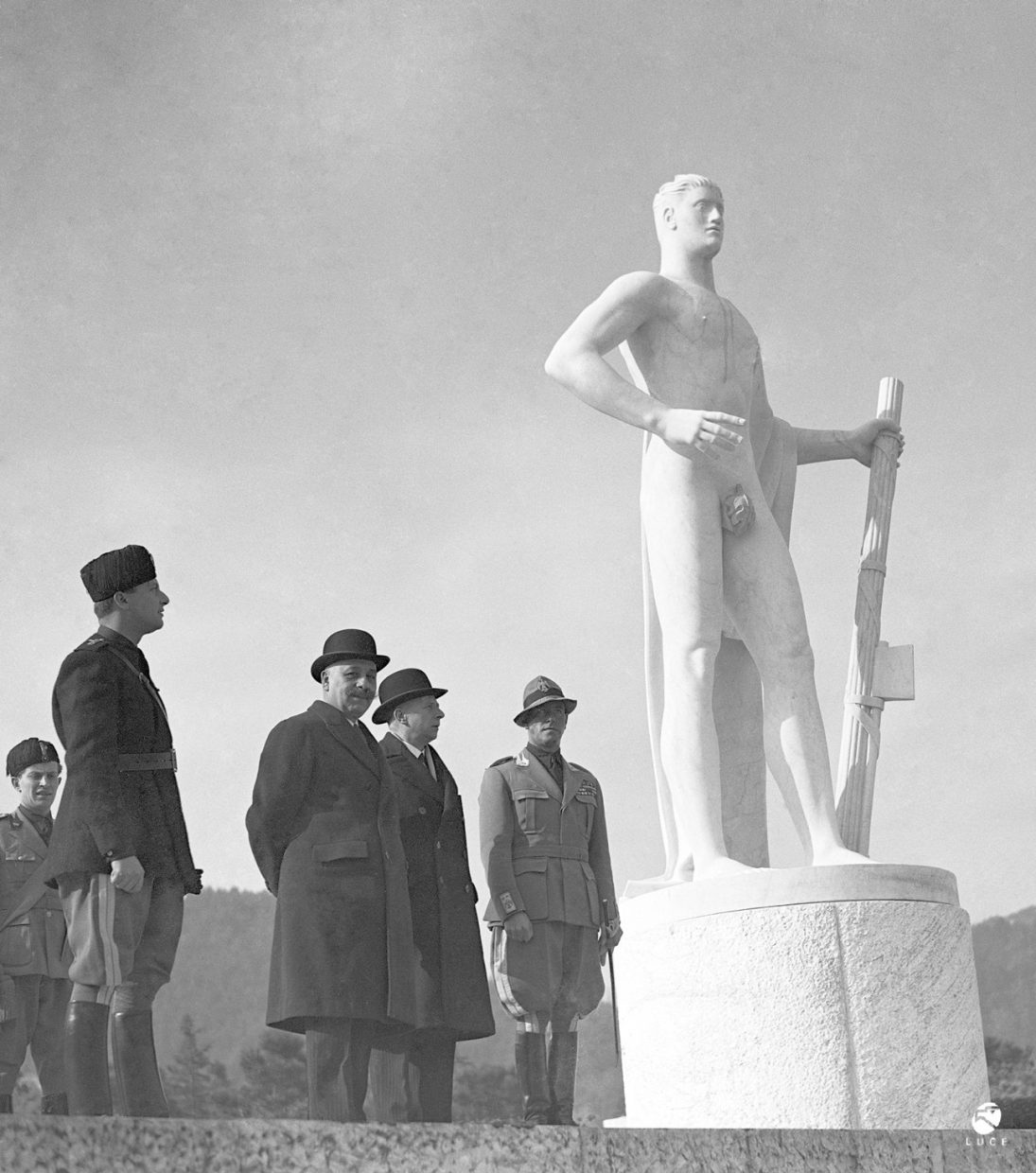‘A New Type of Diplomatic Treaty’ for Cultural Relations: Rome, 1935
This accompanies Benjamin G. Martin’s Contemporary European History article ‘The Birth of the Cultural Treaty in Europe’s Age of Crisis’
It was a busy day in Rome for Hans Pernter. On an official visit to Italy’s capital on 2 February 1935, Pernter, undersecretary at Austria’s Ministry of Education, was led on a tour of the building site of the University of Rome’s imposing new Città universitaria and then was driven across town to the Foro Mussolini sports complex. There, as we see in this image (and in this Istituto LUCE newsreel), he was guided among the stadium’s oversized neo-classical nudes, before reviewing a military-style parade of students from the regime’s renowned Fascist Academy of Physical Education. Beyond highlighting novel elements of fascism’s educational politics, the visit reaffirmed the close ties that existed in 1935 between Austria and Italy. Benito Mussolini had cultivated Austria’s leadership for years, offering to act as guarantor of the country’s security while seeking to establish Italy as the hegemonic power in the Danube basin – a project he had advanced with the so-called Rome Protocols, signed by the leaders of Italy, Austria and Hungary in March 1934.

The stakes of Italy’s outreach to the Austrians had only grown since local Nazis murdered Austrian Chancellor Engelbrecht Dollfuss – whom Mussolini saw as his ideological protégé – in July 1934. Now the time had come to expand and deepen ties between the two nations, using a new set of tools: exchanges in the field of culture. Indeed, the high point of Pernter’s day in Rome came when he met with Mussolini and signed another treaty: a bilateral accord ‘for the development of cultural relations’ between Italy and Austria. Mirroring the Pact of Rome arrangement, but now in the cultural realm, Mussolini signed a similar agreement with Hungary’s education minister two weeks later. (And yes, Hungary’s minister was taken to the same sites in Rome on the occasion of his visit.)
Treaties are an age-old tool of diplomacy, so it seems unsurprising that cultural diplomacy should involve cultural treaties. But the document Pernter and Mussolini signed that day was regarded as a major innovation. According to a 1935 report on the subject by the League of Nations-affiliated International Institute of Intellectual Cooperation, states had occasionally signed relatively narrow agreements on academic exchange since the late nineteenth century, a practice which France had expanded since the end of the First World War. But Italy’s accord with Austria was something else. It outlined an ambitious and durable program of cooperation and exchange, stipulating the creation of national cultural institutes; the creation of professorships in the language and culture of the opposite country; and exchanges in literature, theatre, the visual arts, cinema and radio. The agreement with Hungary was similarly extensive. On the basis of these two accords, the Institute’s report concluded ‘that a new type of diplomatic treaty is beginning to develop’.
The emergence of this new type of treaty is the subject of my article in Contemporary European History (‘The Birth of the Cultural Treaty in Europe’s Age of Crisis’). In it I explore the two types of agreements identified in the Institute’s 1935 report: the narrow, academic exchange agreements France embraced in the 1920s, which it called ‘intellectual’ accords, and the new type, pioneered by fascist Italy in the 1930s, that it instead called ‘cultural’ treaties. Focusing on these states’ use of such agreements with countries in Central-Eastern Europe, I explore them in two ways. First, I place the use of these diplomatic tools in the context of the crises – but also opportunities – that French and Italian elites perceived in the region at the time. Second, I treat these agreements as cultural texts, interpreting their language in terms drawn more from intellectual history than from diplomatic history. This approach reveals similarities between the two states’ concerns, but also highlights the deep ideological differences between the treaty models they developed. I find in particular that the cultural treaties Mussolini signed in February 1935 applied state power to international cultural exchange, and mobilised the idea of ‘culture’ itself, in ways that were new – and that would prove influential long after his fascist regime had fallen.
Pernter’s 1935 visit to Rome would, in other words, leave a legacy substantially more durable than a few photos and a newsreel clip. The agreement he and Mussolini signed was, rather, another demonstration of a central argument of this special issue of Contemporary European History: that the ideological conflicts of Europe’s interwar age of crisis stimulated the development of new cultural-diplomatic strategies and tools, many of which are still with us today.
Read all articles in the collection
Main image credit: Istituto LUCE-Cinecittà





